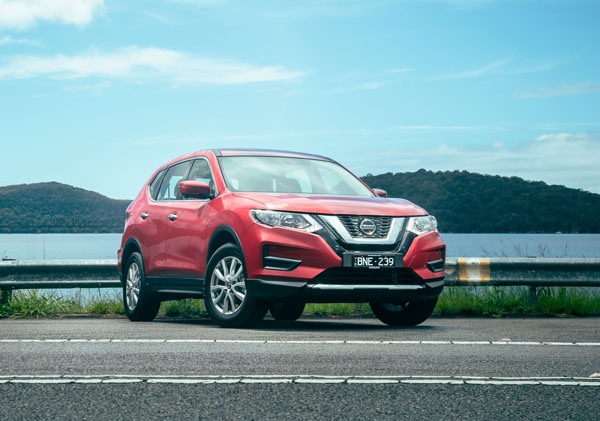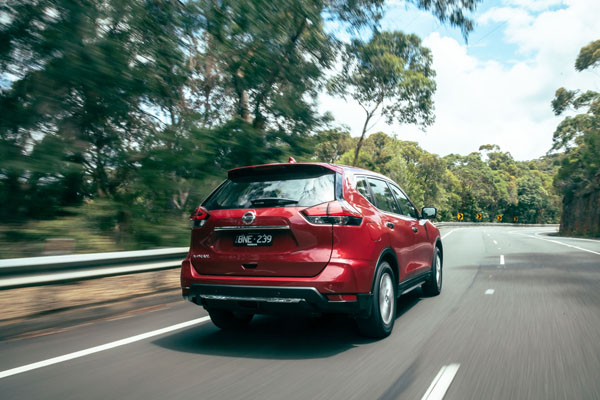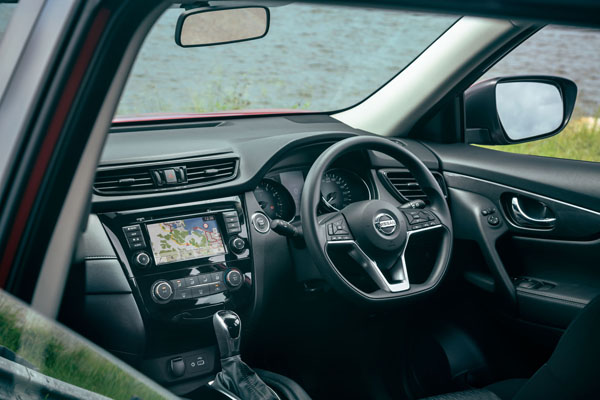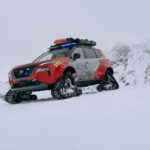
It’s been way too long since I last drove a Nissan X-Trail. After they introduced the CVT
transmission, I kinda lost interest.
But somewhere along the way, I’m happy to say, the X-Trail got its mojo back — the latest
one ain’t half bad.
And, with an all-new model about to lob, my timing was perfect because now I can’t wait to
see where they’ve gone with it.
Prices for X-Trail start from $30,665 for the five-seat ST manual with a 2.0-litre engine.
Standard kit includes cloth trim, manual adjust air conditioning, 17-inch alloys, intelligent
key, push-button start, auto lights, LED daytime running lights, heated and cooled cup
holders, folding electric mirrors and a rear roof spoiler.
The flexible seating system is also part of the deal, with a second-row that split folds
40:20:40 as well as sliding and reclining, along with a flexible cargo system in the five-
seater.
The ST+ adds satellite navigation, front and rear parking sensors and a surround view
camera with moving object detection.
Our test vehicle, the recently introduced two-wheel drive ST+, priced from $34,140, adds
around-view monitor, moving object detection, front and rear park sensors, plus satellite
navigation.
You want all-wheel drive, it’s another $2000 — but quite frankly we wouldn’t bother.

Nissan X-Trail is covered by a 5-year unlimited kilometre warranty, with five years roadside
assistance too.
Scheduled maintenance is due every 12 months/10,000km (first service is $245).
INFOTAINMENT
Infotainment consists of a 7.0-inch touchscreen, six-speaker audio, Bluetooth, voice
recognition, digital radio, with satellite navigation plus Apple CarPlay and Android Auto
compatibility.
ENGINES / TRANSMISSIONS
The X-Trail ST with manual transmission gets a 2.0-litre petrol engine, with 106kW and
200Nm.
The rest of the range is equipped with a more powerful 2.5-litre petrol engine that puts out
126kW of power and 233Nm of torque, the latter from 4400 revs.
The 2.5, paired with Nissan’s Xtronic CVT with manual mode, offers a useful combo of
economy and performance, with claimed fuel consumption of 7.9L/100km.

SAFETY
The safety story is a strong one, with a five-star rating, but sadly the entire suite of
assistance systems is not standard across the range.
Standard are six airbags, auto emergency braking with Forward Collision Warning, rear
view camera, vehicle dynamic control, active trace control, active engine brake and body
motion control, ABS, EBD and brake assist, hill start assist and hill descent control (the
latter with the AWD version).
Moving further up the food chain brings Blind Spot Warning and Rear Cross Traffic Alert,
but it’s not until you get to the top-of-the-line Ti that it’s all there.
That means Lane Departure Warning, Lane Departure Prevention, AEB with pedestrian
detection, Intelligent Cruise Control and High Beam Assist.
Child restraint includes left and right IsoFix and top tethers plus a tether for the centre
position.
DRIVING
Nissan pioneered CVTs, estimating that if the world switched to this kind of transmission, it
would provide a 10 per cent saving in fuel overnight — not to mention reduced engine
emissions.
Instead of a set range of gears, CVTs operate on a continuously variable principle,
designed to deliver the optimum mix of power and efficiency — in theory at least.
CVTs have gotten better since those early days and the latest setup in the X-Trail is for the
most part quite acceptable.
As luck would have it, our time in Nissan X-Trail coincided with a trip out west for a holiday
break, so we got to have a good long look at the car.
With two kids, small dog, a 40-litre car fridge and gear for a few days on the farm, I was
dubious whether the whole lot was going to fit.
It was a tight squeeze, but once we had the two child seats in place, we were able to slide
the second row forward which together with a false removable floor in the cargo area —
provided considerably more space.
The seats are comfy, the ride is compliant and there’s rear air outlets to keep the kids from
becoming car sick (but it’s manual-adjust air conditioning).
All good so far, but a twitchy ride, thanks to a grabby stability system, my wife who started
to feel ill (my four-year-old grandson actually threw up).
Our destination lay four hours northwest of Sydney in the Barrington Tops area of NSW, at
the end of a rather remote 20km of dirt.
Although the test car had front-wheel drive, it remained impressively stable, even on what
at times was a wet and slippery road, washed out in parts from the recent rains.
Both two- and all-wheel drive versions come fitted with Hill Start Assist, but the AWD also
gets Hill Descent Control. This automatically applies the brakes when taking off to prevent
the driver from rolling backwards on an incline.
While we’re on the subject of the brakes the X-Trail comes with a foot-operated parking
brake. Not sure what the thinking is here? It’s less of an issue once you become used to it.
Apart from Eco mode, the value proposition ST+ has no drive modes nor does it get gear
change paddles, but you can change sequentially using the transmission lever, with six
steps provided.
In the context of dirt, this provides some much-needed engine braking when easing off the
accelerator, lifting the level of control in slippery conditions.
Our test vehicle was fitted with smallish 17-inch wheels, with 225/65 series Yokohama
Geolanders, and a space saver spare.
From past experience, we’re not huge fans of the tyres which lack grip in the wet, but they
performed well on this occasion. They are, however, noisy on coarse chip bitumen.
Inside, it’s nothing flash, but functional and starting to look a bit dated.
The steering cover is standard vinyl, rather than leather trimmed and the small
infotainment screen is embedded in the dash as was the norm five years ago.
Two simple analogue gauges and central driver info display make up the instrument
cluster, with the ability to display the car’s speed digitally — but none of the latest eye
candy.
The touchscreen offers a rear-view camera, but at 7.0 inches it’s a trifle small, low-res and
difficult to make out at night.
A 12-volt outlet is provided in the cargo area for powering things like fridges.
Items missing from the equipment list that we missed include blind spot warnings and
adaptive cruise control.
A 60-litre fuel tank takes standard 91 unleaded. Rated at 7.9L/100km, we were getting
7.7L/100km after 1120km, including city and rural, dirt and bitumen driving.
SUMMING UP
Credit where credit is due, the Nissan X-Trail is a much-improved motor vehicle. The size
is right, the balance of power and economy is right and the configurable cargo and second
row areas are a major drawcard.
Although the fitout is starting to show its age, it remains functional and offers value for
money. Let’s hope the new one when it arrives later this year addresses any shortcomings
— but these things are never a given.
RATINGS:
Looks: 7.5/10
Performance: 7/10
Safety: 7/10
Thirst: 8/10
Practicality: 8/10
Comfort: 7.5/10
Tech: 7.5/10
Value: 7.5/10
Overall: 7.5/10
AT A GLANCE
MODEL RANGE
ST Manual (2.0-litre petrol), $30,665
ST Auto, $32,665
ST 7 Seats, $34,265
ST 4WD, $34,665
ST+, $34,140
ST+ 4WD, $36,140
ST-L, $38,675
ST-L 7 seats, $40,275
ST-L 4WD, $40,675
Ti 4WD, $46,115
Ti Tan-Leather 4WD, $46,115
Note: These prices do not include government or dealer delivery charges. Contact your
local Nissan dealer for drive-away prices.
SPECIFICATIONS (Nissan X-Trail ST+ 2.5L 4-cylinder petrol, CVT automatic, FWD SUV)
PERFORMANCE:
Capacity: 2.5 litres
Configuration: in-line four
Maximum Power: 126 @ 6000 rpm
Maximum Torque: 233 @ 4400 rpm
Fuel Type: 91 RON petrol
Combined Cycle (ADR 81/01): 7.9L/100km
CO2 Emissions: 183 g/km
DRIVELINE: CVT automatic, front-wheel drive
DIMENSIONS, WEIGHT AND CAPACITIES:
Length: 4690 mm
Wheelbase: 2705 mm
Width: 1820 mm
Height: 1740 mm
Fuel Tank Capacity: 60 litres
Kerb Mass: 1458 kg
BRAKES:
Front: Ventilated disc
Rear: Ventilated disc
STANDARD WARRANTY:
Five years/unlimited kilometres











